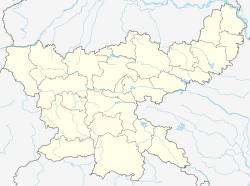Navratangarh
Navratangarh (Doisagarh) was one of the capitals of the Nagvanshi dynasty, who ruled parts of what is now the state of Jharkhand, India. It is located in Sisai block of Gumla district. It is said that king Durjan Shah shifted his capital from Khukhragarh to Navratangarh.[1] He constructed the fort between 1636 and 1639.[2][3][4][5] The palace was a five-storeyed structure with its "water-gate" and garh-khai (moat) arrangement. It has a kiaclmy (court), a treasury house and a prison-cell with its underground dungeon.[6] [7][8] It was declared national heritage in 2009.[9][10] Overview 17km 10.6miles C H H A T T I S G A R H X North Karo River W Sankh River V South Koel River T Palkot Wildlife Sanctuary H Nagfeni H Navratangarh H Marda CT Toto CT Ghaghra M Gumla R Sisai R Raidih H Palkot R Kamdara H Khukhragarh M Ranchi H Ratu R Bharno R Basia Cities, towns and locations in Gumla district in South Chotanagpur Division M: municipality, CT: census town, R: rural/ urban centre, H: historical/ religious centre, T: tourist centre, B: Bauxite mining centre The Navratragarh fort is located in Sisai block of Gumla district. It is located in around 30 km from Gumla and 75 km from Ranchi.[2][3] History  It is said that king Durjan Shah shifted his capital from Khukhragarh to Navratangarh.[1] He constructed the fort between 1636 and 1639 CE. After his release from Mughal captivity, the Raja decided to build the fort. Navratangarh was in a strategic location as it was surrounded by forests, hills and rivers.[7][11] King Ram Shah built Kapilnath Temple in 1643. He succeeded by Raghunath Shah. He also built several temples. Yadunath Shah shifted capital to Palkot due to Mughal invasion.[12] ReferencesWikimedia Commons has media related to Navratangarh.
|
||||||||||||||||||||||||||||
















